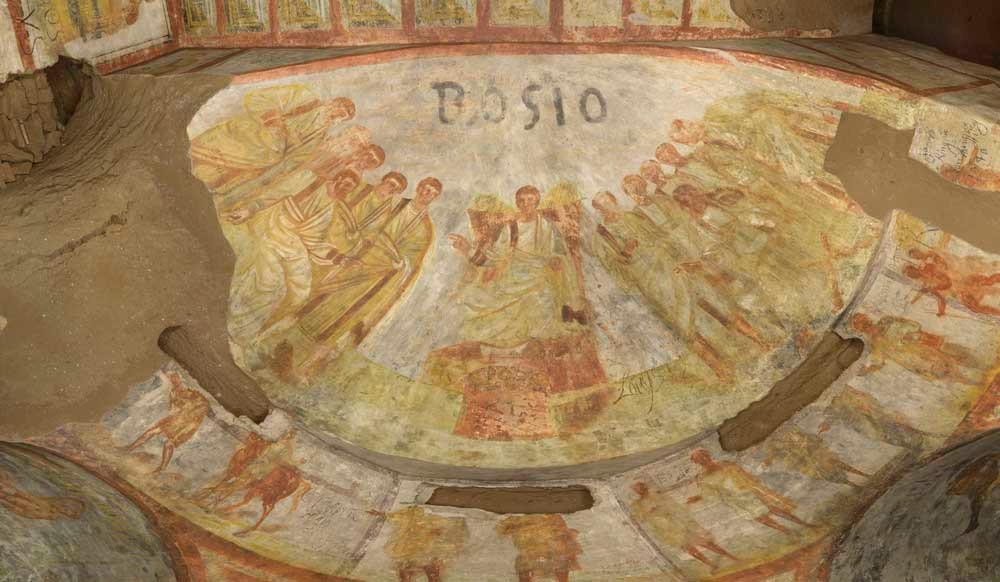The Pontifical Commission for Sacred Archaeology

Profile
The Commission was created by Pius IX (January 6, 1852) “to take care of the ancient sacred cemeteries, look after their preventive preservation, further explorations, research and study, and also safeguard the oldest mementos of the early Christian centuries, the outstanding monuments and venerable Basilicas in Rome, in the Roman suburbs and soil, and in the other Dioceses in agreement with the respective Ordinaries”. Pius XI made the Commission pontifical (Motu Proprio I primitivi cimiteri, [The primitive cemeteries] of December 11, 1925) and expanded its powers. Through the Lateran Pacts (art. 33 of the Concordat), its authority and its sphere of action and study were extended to all the existing catacombs on the Italian territory. The new Concordat of 1984 (art. 12) confirmed this state of affairs for the Christian catacombs. “In the places entrusted to it, nothing can be modified without its permission; it directs any work to be done and publishes its results; it establishes the rules for access by the public and scholars to the sacred cemeteries and indicates which crypts can be used for the holy liturgy and with what precautions”.
Through the Commission, the work of the Roman Pontifical Academy of Archaeology and the Pontifical Institute of Christian Archaeology is coordinated. Moreover, the Commission continues to be interested in the activity of the Society for the Conferences of Christian Archaeology and the Collegium Cultorum Martyrum (Motu Proprio di Pio XI, December 11, 1925; Regulations for the P.C.S.A., §II, No. 10). (Annuario Pontificio, 2001, pp. 1621-1622).
The president of the Pontifical Commission for Sacred Arqueology is Mons. Pasquale Iacobone; The Secretary is Dr. Raffaella Giuliani; the officers are: Dr. Barbara Mazzei, Geom. Giuseppe Fiorenza, Rag. Giovanni Nuccetelli, Sr. Piero Crescenzi, Sra. Emanuela Tesse; The members are: S.E.R. Carlos Alberto de Pinho Moreira Azevedo, Prof. Matteo Braconi, Prof. Paola De Santis, Rev. Prof. Hubertus R. Drobner, Prof. Carlo Ebanista, Mons. Pasquale Iacobone, Prof. Paolo Liverani, Prof. Danilo Mazzoleni, Prof. Michel-Yves Perrin, Prof. Marcello Rotili, Prof. Rossana Martorelli, Prof. Maria Carla Somma; The local inspectors are: Dr. Barbara Mazzei (Lazio); Prof. Maria Carla Somma (Abruzzo); Prof. Carlo Ebanista (Campania), Dr. Gioacchina Tiziana Ricciardi (Eastern Sicily), Prof. Rosamaria Carra (Western Sicily), Prof. Matteo Braconi (Tuscany and Umbria), Prof. Rossana Martorelli (Sardinia), Prof. Paola De Santis (Puglia).
Historical note
The Commission for Sacred Archaeology was created through an idea of Giovanni Battista de Rossi, the Roman archaeologist who laid the scientific bases of Christian archaeology and studied and excavated the Roman Catacombs following a modern topographical method that takes the historical sources and the monuments into consideration simultaneously.
De Rossi suggested to the Supreme Pontiff Pius IX to create the Commission in order to improve the organization of the excavations, the restorations and the protection of the great catacomb complex of St. Callixtus that was coming to light again on the Appian Way. The news was divulged on February 7, 1852, even though the actual institution referred to January 6th when at last a Commission was created “for the more effective protection and surveillance of the cemeteries and ancient Christian buildings of Rome and its suburbs, for the systematic and scientific excavation and exploration of the same cemeteries, and for the preservation and upkeep of what was found or brought to light again by the excavations”.
In 1925, Pope Pius XI declared that the Commission was Pontifical and its competencies were defined in detail and reaffirmed recently in the conventions between the Holy See and the Italian State whereby, “The Holy See maintains the availability of the Christian catacombs of Rome and the other parts of the Italian territory with the resulting responsibility for their care, maintenance and preservation (Motu Proprio di Pio XI. Della Pontificia Commissione di Archeologia Sacra e dal nuovo Pontificio Istituto di Archeologia Cristiana, Vatican City 1925 = Acta Apostolicae Sedis. Inter Sanctam Sedem et Italiam Conventiones initae diebus 18 febr. et 15 nov. 1984, Vatican City 1985).
From that moment on, the activity of the Pontifical Commission for Sacred Archaeology has never ceased, not even during the grave circumstances of World War II. Immediately after the war, Father Antonio Ferrua gathered up the few human forces and the minimum economic resources to retrieve the precious Paleo-Christian archaeological patrimony constituted by the more than 140 Christian catacombs scattered over the Italian territory.
In recent times, the Pontifical Commission for Sacred Archaeology has received a great impulse regarding both its archaeological and conservationist activities, which are carried out according to the most modern excavation and restoration criteria, as well as its technical, documentary and operational organization in order to offer an ever more valid and effective support to knowledge and protection of the valuable monumental and spiritual patrimony entrusted to it.
The offices of the Pontifical Commission for Sacred Archaeology are located in the Palace of the Pontifical Institute of Christian Archaeology, Via Napoleone III, I – 00185, Rome – Phone. +39/06.44.65.610; +39/06.44.67.601; e-mail: protocollo@arcsacra.va - pcas@arcsacra.va





